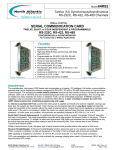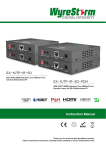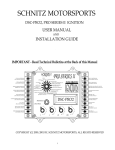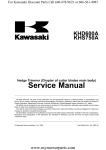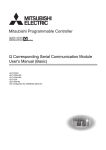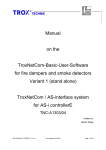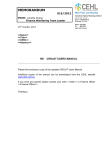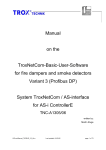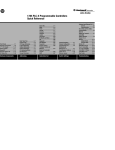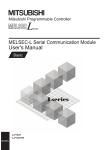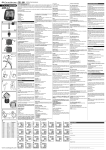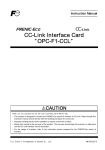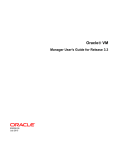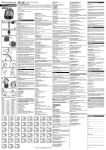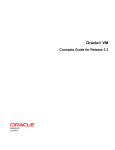Download Technical manual BIS-S404
Transcript
BIS M699 Processor Technical Description, User's Guide www.balluff.com Page 2 of 84 Safety instruction Read this section thoroughly before using the device! Before using the controller, read this manual carefully. During installation and operation, pay close attention to the safety aspect. Planning the System Design the system to work safety if the processor should be damaged or the power unit malfunction. Do not exceed the specifications for supply voltage, conditions for use, etc. as indicated in this manual. Handling the System Observe the rated voltage that is indicated in the specifications. Misuse may cause excessive heat leading to possible to fire. Take care when connecting the system, as incorrect wiring may cause unexpected malfunction of the machine. Ensure the power is switched off during installation or maintenance operations. Do not dismantle or modify the devices. This could cause malfunction or overheating. Page 3 of 84 [Contents] Safety instruction ..................................................................................................................................3 Planning the System ............................................................................................................3 Handling the System............................................................................................................3 1 User instructions ................................................................................................................................6 1.1 CE Declaration of Conformity and user safety ...............................................................6 1.2 Scope of delivery ...........................................................................................................6 1.3 About this manual ..........................................................................................................6 1.4 Structure of the manual..................................................................................................6 1.5 Typographical conventions.............................................................................................7 1.6 Symbols .........................................................................................................................7 1.7 Abbreviations .................................................................................................................7 2 Safety.................................................................................................................................................8 2.1 Abbreviations .................................................................................................................8 2.2 General safety notes......................................................................................................8 2.3 Meaning of the warning notes ........................................................................................8 3 Getting Start .......................................................................................................................................9 3.1 Mechanical connection ..................................................................................................9 3.2 Electrical connection ......................................................................................................9 3.2 Project administration ..................................................................................................10 4 Basic Knowledge .............................................................................................................................18 4.1 Function principle of Identification Systems .................................................................18 4.2 Product description ......................................................................................................18 4.3 Control function............................................................................................................18 4.4 Bus connection ............................................................................................................18 4.5 System configuration ...................................................................................................19 4.6 Construction of the Components and applicable units .................................................20 5. Technical Data ................................................................................................................................21 5.1 Dimension ....................................................................................................................21 5.2 Mechanical Data ..........................................................................................................21 5.3 Electrical Data..............................................................................................................21 5.4 Operating Conditions ...................................................................................................22 5.5 Function Indicators.......................................................................................................22 5.6 Performance specification............................................................................................22 6. Implementation and Installation ......................................................................................................23 6.1 Attaching ......................................................................................................................23 6.2 Positioning ...................................................................................................................23 6.3 Interface information/ Wiring diagrams ........................................................................24 6.3.1 Cable for CC-Link ..........................................................................................25 6.3.2 Wiring to Each Unit ........................................................................................25 7. Function ..........................................................................................................................................27 7.1 Function list..................................................................................................................27 7.1.1 Outline of functions ........................................................................................27 7.2 I/O Signals for Master Unit ...........................................................................................28 7.2.1 Input-Output Signal list ..................................................................................28 7.2.2 Input-Output Signal details ..........................................................................29 7.3 Remote Register allocation .......................................................................................32 7.3.1 Remote Resistor list.......................................................................................32 7.3.2 Remote Resistor details.................................................................................33 7.4 Memory Address of data carrier ...................................................................................37 7.5 Data processing time ...................................................................................................38 8. Indications and Settings..................................................................................................................39 9. Prior to programming ......................................................................................................................41 9.1 Connecting example of the System and Processing Data ...........................................41 9.2 Data structure (Processing unit)...................................................................................42 9.3 data carrier memory .....................................................................................................42 9.4 Interlock .......................................................................................................................43 9.5 Faulty Condition of Data Link .......................................................................................44 10. Communication Procedure with data carrier .................................................................................45 10.1 Instruction for programming .......................................................................................45 10.2 List of Instructions and Commands ............................................................................46 Page 4 of 84 10.3 System be used in this Chapter .................................................................................47 10.4 Sequence Program for ACPU ....................................................................................48 10.5 Basic Format of Program ...........................................................................................49 10.5.1 Processing program when fault condition occurred .....................................51 10.6 Initial setting ...............................................................................................................52 10.7 Reading Data Instruction............................................................................................57 10.7.1 Reading instruction (RD, CR) ......................................................................57 10.7.2 Sequence Reading Instruction (AR, SR) .....................................................60 10.8 Writing Data Instruction..............................................................................................63 10.8.1 Writing instruction (WD,CW) ........................................................................63 10.8.2 Sequence Writing Instruction (AW,SW) .......................................................66 10.8.3 Batch Writing Instruction (FI) .......................................................................69 10.9 Comparison Instruction (CM) .....................................................................................71 10.10 Clear Instruction (CL) ...............................................................................................74 10.11 Stop Command of Sequence Instruction ..................................................................76 10.12 Error Cancellation Instruction...................................................................................77 11. Trouble Shooting ...........................................................................................................................78 11.1 List of Error Code .......................................................................................................78 11.2 Trouble Shooting ........................................................................................................79 11.2.1 Confirming Procedure with LED indicator ....................................................79 11.2.2 Procedure for Fault of Data Link ..................................................................81 Appendix.............................................................................................................................................83 A1 BIS M-699 Ordering information ...................................................................................83 A2 Accessories (optional, not included) .............................................................................83 <NOTE> (1) The contents and the specification are subject to change without notice. (2) If any mistakes or errors are found in this manual, please inform us. Page 5 of 84 1 User instructions 1.1 CE Declaration of Conformity and user safety This product was developed and produced in compliance with applicable European standards and directives. Declaration of Conformity This product was developed and produced in compliance with applicable European standards and directives. Note You can request a Declaration of Conformity separately. For additional safety instructions, refer to the "2 Safety" section on page 8 1.2 Scope of delivery Included in the scope of delivery: --- BIS C-699 CC-Link Processor --- Cover cap for Head 2 and X3 CC-Link out --- BIS software CD --- Operating instructions in printed form (GER/ENG) 1.3 About this manual This manual describes processors in the series BIS M-699 identification system as well as start-up instructions for immediate operation. The present manual does not describe: --- Start-up, operation, and care of the "PC and PLC’’, --- Installation and operation of accessories and expansion devices, 1.4 Structure of the manual The manual is organized so that the sections build on each other. Section 2: Basic safety information Section 3: Key steps for installing the Identification System Section 4: Introduction to the material Section 5: Technical data for the processor Section 6: Handling instructions and installing environment Section 7: Functions Section 8: Status Indication and user-defined settings Section 9: Prior to programming Section 10: Programming procedure to communicate with data carrier Section 11: Trouble Shooting Page 6 of 84 1.5 Typographical conventions Enumerations Enumerations are shown as a list with en-dash. --- Entry 1, --- entry 2. Actions Action instructions are indicated by a preceding triangle. The result of an action is indicated by an arrow. ► Action instruction 1. Action result. ► Action instruction 2. Syntax Numbers --- Decimal numbers are shown without additional indicators (e.g. 123), --- Hexadecimal numbers are shown with the additional indicator hex (e.g. 00hex). Parameters Parameters are shown in italics (e.g. CRC_16). Cross-references Cross-references indicate where additional information on the topic can be found (see ‘‘5. Technical Data‘‘ section on page 21). 1.6 Symbols ______________________________________________________________________________________________ Attention! This symbol indicates a safety instruction that must be followed. ______________________________________________________________________________________________ ______________________________________________________________________________________________ Note, tip This symbol indicates general notes. ______________________________________________________________________________________________ 1.7 Abbreviations BIS CRC EMC PC PLC RFID Balluff Identification System Cyclic Redundancy Check Electromagnetic Compatibility Personal Computer Programmable Logic Controller Radio Frequency Identification Page 7 of 84 2 Safety 2.1 Abbreviations The BIS M-699 processor is a component of the BIS M Identification System. Within the Identification System it is used to for connecting to a host computer (PLC, PC). It may be used only for this purpose in an industrial environment corresponding to Class A of the EMC Law. This description is valid for processors in series BIS M-699 2.2 General safety notes Installation and start up Installation and start up are to be performed only by trained personnel. Any damage resulting from unauthorized manipulation or improper use voids the manufacturer's guarantee and warranty. When connecting the processor to an external controller, observe proper selection and polarity of the connection as well as the power supply (see "6. Implementation and Installation" section on page 23). The processor may be operated only using an approved power supply (see "5. Technical Data’’ section on page 21) Operation and testing The operator is responsible for ensuring that local safety regulations are observed. When defects and non-clearable faults in the Identification System occur, take the system out of service and secure it against unauthorized use. 2.3 Meaning of the warning notes ______________________________________________________________________________________________ Attention! The pictogram together with the expression "Attention!‘‘ warns of a possible hazardous situation for the health of persons or of equipment damage. Disregard of these warning notes may result in injury or damage to equipment. ► Always observe the described measures for preventing this danger. ______________________________________________________________________________________________ Page 8 of 84 3 Getting Start 3.1 Mechanical connection Mechanical connection (dimensions in mm) 1 2 3 4 Connector head 2 Connector head 1 Tightening torque 0,8…1,2 Nm, Tightening torque 7,8... 11,8 Nm, ► Attach processor using 4 M4 screws. 3.2 Electrical connection X1 Power - male 5 pol. X2 CC-Link In - male 5 pol. X3 CC-Link Out - female 5 pol. 1) View towards connector ______________________________________________________________________________________________ Attention! Make the ground connection either directly or using an RC combination to ground. When making your connection to the CC-Link, be sure that the shield is perfectly connected to the connector body. ______________________________________________________________________________________________ Page 9 of 84 3.2 Project administration Project administration with Mitsubishi PLC Q CPU Exemplarily used modules: Balluff Identifications system: Programming software: BIS M-699-052-050-03-ST11 GX IEC Developer from Mitsubishi Mitsubishi controller (PLC): Base Unit Power supply CPU CC-Link System Master Input Module Output Module Q38B-E Q61P Q03UDCPU QJ61BT11N QX80-TS QY80-TS connected via USB interface to PC slot 0 mandatory slot 1 optional slot 2 optional For this example used hardware settings and wiring: Settings according to “8. Indications and Settings” page 39 and wiring according “6.3 Interface information/ Wiring diagrams” to page 24 CC-Link System Master Module: Station number 0 look at user manual Mitsubishi System Master System Baud rate 10 Mbps BIS M 699 Station number 1 Baud rate 10 Mbps Mode 2 heads activ Switch 1 ON (STATION No) Switch 4 ON (B RATE) RYn2 OFF Page 10 of 84 Step by step Step 1: Power On Status LED of BIS M 699: PW --> ON RUN --> ON L-RUN --> ON SD --> ON RD --> ON Step 2: Open customer project. Figure 1: Project Step 3: Read PLC data Set the PLC structure at the folder I/O assignment. Figure 2: PLC parameter Page 11 of 84 Press the button "Read PLC data" to read out the assignment. Figure 3: I/O assignment Press the button "Check" and "End" to store the settings. To verify the settings press „Acknowledge XY assignment“. Figure 4: I/O assignment Page 12 of 84 Step 4: CC-Link Network Figure 5: Network parameter Press the button "CC-Link" to open network parameter setting. Figure 6: Network setting Page 13 of 84 In the table is to see the network settings for the example: Figure 7: CC-Link settings For more details see “10.6 Initial setting“. No. of boards in module Start I/O No. Type Mode All connect count Remote input RX Remote output RY Remote Register (RWr) Remote Register (RWw) Special relay (SB) Special Register (SW) Retry count Automatic reconnection station count Delay information setting 1 board 0000 Master-Station Remote Net (Ver. 1 Mode) 1 M208 M336 D200 D100 SB0 SW0 3 1 0 Station information setting: Figure 8: Station information setting Station type Exclusive station count Remote device station Exclusive station 4 Page 14 of 84 Remote device station initial setting: Figure 9: Initial setting These settings will be executed during the PLC boot up to initialise the BIS M-699. For more details see “10.6 Initial setting". Page 15 of 84 Step 5: Initialise ladder This ladder is needed to start the communication with BIS M-699 and to activate the R/W head. For more details see "7.2.2 Input-Output Signal details”, ”7.3.1 Remote Resistor list”, ”7.3.2 Remote Resistor details” and “10.6 Initial setting”. Example generated in POU "MAIN_PRG_LD". Figure 10: POU_Pool Ladder structure: Figure 11: Init ladder Page 16 of 84 Step 6: Save project Compile project (Menu --> Project -->"rebuilt all") Transfer project to CPU CPU RESET CPU RUN LED state information of CPU: MODE RUN green/ON green/ON LED state of CC-Link System Master Module RUN L_RUN MST SD green/ON green/ON green/ON green/ON LED state of BIS M-699 RUN L_RUN MST SD RD red/ON red/ON red/ON red/ON red/ON Head1: IN-Z red/ON if data carrier in field. Head2: IN-Z red/ON if data carrier in field. Read-/Write function see manual Page 17 of 84 4 Basic Knowledge 4.1 Function principle of Identification Systems The BIS M Identification System is classified as a non-contacting system with read and write function. This makes it possible to not only transport information which is fixed programmed in the data carrier, but also to collect and pass on current information. The main components of the BIS M Identification System are: --- Processor, --- Read/write heads, --- Data carriers. The main areas of application are: --- In production for controlling material flow (e.g. in model-specific processes), in work piece transport with conveying systems, for acquiring safety-relevant data, --- In warehousing for monitoring material movement, --- Transporting and conveying. 4.2 Product description Processor BIS M-699: is connected to CC-Link as a remote device station and communicates with sequencer CPU of master/ local station. --- Metal housing, --- Supply voltage X1 and CC-Link connections X2 / X3 with M12 connectors, --- Two read/write heads can be connected, --- Read/write heads are suitable for dynamic and static operation, --- Power for the system components provided by the processor, --- Power for the data carrier provided by the read/write heads via carrier signal. Arrangement of the read/write heads: Which arrangement of the read/write heads makes the most sense depends essentially on the possible spatial arrangement of the components. There are no functional restrictions. Distance and relative speed depend on the characteristics of the data carriers used. Note If two read/write heads are connected to the BIS M-699 processor, both can be operated independently of each other: One data carrier can be read at the first read/write head, while a different data carrier can be written to at the second read/write head. ______________________________________________________________________________________________ 4.3 Control function The processor is the link between data carrier and controlling system. It manages two-way data transfer between data carrier and read/write head and provides buffer storage. The processor uses the read/write head to write data from the controlling system to the data carrier or reads the data from the carrier and makes it available to the controlling system. Host systems may be the following: --- A control computer (e.g. industrial PC), --- A PLC. 4.4 Bus connection Processor and controlling system are connected via CC-Link. The CC-Link (decentralized peripheral) is tailored to communication between a controller and decentralized field devices. Page 18 of 84 4.5 System configuration Function of each Component Component Function Data carrier A data medium that stores and retains information (data). It reads and writes data carrier information/data without physical contact as well as supplies power for data carrier. Read/write head Processor CC-Link Master/Local Station When it receives instructions from sequencer CPU, it executes reading or writing data to or from data carrier. It can be connected 1 or 2 read/write head(s). A sequencer CPU unit which instructs for CC-link and a master unit station which controls CC-Link system. Note for System construction The occupied stations of Processor BIS M-699 are 4 stations, therefore, plural processors can be connected to a master unit within the allowable number of station. Please decide the number of processors to be connected to the master unit in considering the following points. (1) Maximum number of connectable stations for master unit is 16. (occupied 4 stations) (2) The number of occupied station of the units (input/output card etc.) except processors, and Input/Output occupied numbers. (3) Processing time as well as influence to tact time in programming (ladder). Page 19 of 84 4.6 Construction of the Components and applicable units The construction of components of CC-Link system that can be used by the processor BIS M-699 and applicable Units are indicated by the following. The Processor cannot be connected to other units. CC-Link master / Local station (Sequencer CPU unit) Sequencer CPU unit Master unit Type number ACPU A1SHCPU / A1SJHCPU / A2SHCPU A2UCPU / A2UCPU-S1/ A3UCPU/ A4UCPU (After software version Q. For after version K, refer to *1) A2USCPU / A2USCPU-S1 (After software version E. For after version A, refer to *1) A2USHCPU-S1 (After software version L. For after version G, refer to *1) QnACPU Q02CPU / Q2ACPU-S1 / Q3ACPU / Q4ACPU / Q2ASCPU, Q2ASCPU-S1 / Q2ASHCPU / Q2ASHCPU-S1 (After function version B) QCPU(A mode) Q02CPU-A / Q02HCPU-A / Q06HCPU-A QCPU(Q mode) Q02CPU / Q02HCPU-A / Q06HCPU / Q12HCPU / Q25HCPU Type AJ61BT11/ A1SJ61BT11/ AJ61QBT11/ A1SJ61QBT11 Number (After 9707B is indicated in DATE) QJ61BT11 *1 Instruction RRPA (Auto refresh) is only available Processor *2 External Power Unit (DC24V) CC-Link BIS M-699-052050-03-ST11 read/write head*2 BIS M-3xx-001-S115 Identification communication Data carrier *2 BIS M-1xx-01(Mifare) BIS M-1xx-02(ISO15693) *2 ISO15693-compliant data carrier can be used if lot number of the ID controller is 0814JP or later and software of R/W head is newer than V2.0. (To check the lot number or the version, please see a label attached to a unit) Page 20 of 84 5. Technical Data 5.1 Dimension 1 2 3 4 Connector head 2 Connector head 1 Tightening torque 0,8…1,2 Nm, Tightening torque 7,8... 11,8 Nm, 5.2 Mechanical Data Housing material X1 --- POWER X2 --- CC-Link In X3 --- CC-Link Out Head 1, 2 (read/write head connections) Enclosure rating Weight Mounting screw for unit GD-Al 5 pin, male, M12, a-coded 5 pin, male, M12, a-coded 5 pin, female, M12, a-coded 8 pin, female, M12, a-coded IP65 (with connectors) 1150 g 4 x M4 x 25 mm – 8.8-A2B D912 (Tightening torque :7,8...11,8Nm) 5.3 Electrical Data Supply voltage VS Ripple Current draw Device interface 24 V DC ±10 % LPS / Class 2 supplied only ≤ 10 % ≤ 800 mA CC-Link Page 21 of 84 5.4 Operating Conditions Ambient temperature range Storage temperature EMC --- EN 61000-4-2/3/4/5/6 --- EN 55016-2-3 Vibration/ Shock Operating atmosphere 0 °C…+55 °C -20 °C...+75 °C --- Schärfegrad 2A/2A/3B/2B/XA --- class A EN 60068 Part 2-6/27/29/64/32 Without corrosive gas, heavy dust 5.5 Function Indicators BIS operating states for Head 1 and 2 SD RD ID-ERR. IN-Z PW RUN L RUN SD RD L-ERR. CC-Link status head is sending data head is receiving data error data carrier is in zone power on operating normally communicating normally sending data to CC-Link receiving data from CC-Link Communicating data error LED LED LED LED LED LED LED LED LED LED red red red red red red red red red red ___________________________________________________________________________________ Note For detailed description see "8. Indications and Settings" on page 39. ___________________________________________________________________________________ 5.6 Performance specification Applicable data carrier Memory Data retention period Connectable read/write head ID antenna cable length Number of connectable r/w head Number of read/write heads Number of RWr/RWw Communicating data Communicating address range (word address) Data with Data with amount per 1 communication master unit amount per 1 communication head and data carrier CC-Link version Sort of CC-Link station Occupied station BIS M-1xx-01/x 752 bytes(EEPROM) 10 years BIS M-3xx-001-S115 50m (Max. ) 2 Using only Head1 16 words BIS M-1xx-02/x 2000 bytes(FRAM) 10 years 0...999 0...999 Using Head1, Head2 8 words per each head (total 16) 1...12 words 1...5 words 1...1000 words 1...1000 words Ver. 1.10 Remote device station 4 stations (RX/RY each 128, RWr / RWw each 16) Note Read/write command can be available up to 1000 words (3E8H) When larger command than memory capacity is given to data carrier of 752 bytes (376 words), ID processor will accept and execute it. In that case, read/write function is normally executed within the range of memory, but it shows "data carrier communication error" when you access the address outside of the range. For example, "data carrier communication error" is displayed after writing up to 376 words when the command "write to BIS M-1xx-01 (Mifare 376 words) from 0 to 1000 words" is executed. Page 22 of 84 6. Implementation and Installation 6.1 Attaching Note: 1) Connector head 2 2) Connector Head 1 ► Attach processor using with 4 M4 screws. When installing processor (BIS M-699), pay close attention to the following points. (1) Tightening torque for unit and casing cover Place to screw Tightening torque 4) screws for unit (M4) 7,8...11,8 Nm 3) casing cover mounting screws …0,8…1,2 Nm 6.2 Positioning Please install processor BIS M-699 avoiding situations where. a. b. c. d. e. f. Operating temperature exceeds the range of 0...55 degrees C. Dew condensation caused by severe temperature change. Relative humidity exceeds 5...95% Processor is exposed to heavy corrosive gas, combustible gas or dust. Shock or vibration directly to processor. Water, oil or chemical is sprayed on the processor. This Processor is conformed to EMC directive and acquired CE marking. Same as Melsec PLC, the test has been carried out where processor had been installed in the control board. <Attentions> When installing the processor in a panel, please pay close attention to the following points. *Keep adequate ventilation space around the processor. *Processor should be kept apart from radiate heating machine (heater, trance, resistor etc.). *Installing a fan or cooler is recommended in the case of temperature is higher than 55 degrees C. Page 23 of 84 6.3 Interface information/ Wiring diagrams Connections 1 Head 2 – Read/ write head 2 2 Head 1 – Read/ write head 1 3 Function ground PE 4 X3 – CC-Link Out 5 X2 – CC-Link In 6 X1 – Supply voltage X1 Power - male 5 pol. X2 CC-Link In - male 5 pol. X3 CC-Link Out - female 5 pol. 1) View towards connector ____________________________________________________________________________ Attention! Make the ground connection either directly or using an RC combination to ground. When making your connection to the CC-Link, be sure that the shield is perfectly connected to the connector body. When making your function ground, be sure that ‘‘Function ground PE’’ is perfectly connected to the function ground of whole system installation. ____________________________________________________________________________ Page 24 of 84 6.3.1 Cable for CC-Link Use exclusive cable for CC-Link system because the efficiency of CC-Link system is not warranted in applications with any other cable. Refer to brochure CC-Link regarding the specification of cable for CC-Link and inquiry. 6.3.2 Wiring to Each Unit (1) Wiring Master Unit and Processor Unit Refer to following wiring diagram for wiring master unit and Processor unit with cable for CC-Link. <Attention> "Termination resistor" should be connected between DA-DB on both units at the end of CC-Link. In connecting termination resistor with DA-DB, use the termination resistor attached to master unit. (Refer to the user's manual for CC-Link system master and local unit.) (2) Wiring of External Power Unit and Frame Gland Refer to the above wiring diagram to connect external power unit (24V DC) and frame ground. Connect [+] side of 24V DC power unit to the terminal indicated [+ ], and [-] side to [- ]. Connect frame ground to [FG] terminal. Page 25 of 84 (3) Wiring of Read/write head Reference the following diagram, when wiring the read/write head cable to the processor. There are two connectors Head1 and Head2 for connecting two heads. [Wiring diagram] Wiring of connector cable for read/write head Connector cable: BIS-Z-501-PU1-_ _/E (enclosed BKS-S117-00) BIS-Z-502-PU1-_ _/E (enclosed BKS-S117-00) Appropriate connector BKS-S117-00 <Attention> Cable of read/write head should be kept apart from other power cable and high voltage machines. When installing read/write heads on a metal frame, the frame should be grounded to the protective ground conductor. Page 26 of 84 7. Function 7.1 Function list The following functions can be performed with the processor (BIS M-699). Functions Reading Writing Instructions & Instruction cod ASCII Hex. Commands Reading RD 4452H CR 5243H Sequential AR 5241H Reading SR 5253H Writing Sequential Writing Batch writing Check Comparing Clearance Clearing Command Stop Sequence instruction Error cancellation WD CW AW SW 4457H 5743H 5741H 5753H FI 4946H CM CL 4D43H 4C43H Process Reference Reads data from data carrier. Compares data to confirmation. Executes reading in sequence until data carrier gets into communication area, and then executes reading. After that, compares data to check. Writes data to data carrier. Compares data to check. Executes writing in sequence until data carrier gets into communication area, and then executes writing. After that, compares data to check. Writes specified data to specified area in data carrier simultaneously. Compares data of processor with data in data carrier. Clears specified area in data carrier with "0" Cancels sequence instruction compulsively. 10.7.1 Executes error canceling process. (Clearing error LED, resetting error detected signal, Clearing executing result store area in remote resister) 10.7.2 10.8.1 10.8.2 10.8.3 10.9 10.10 10.11 10.12 7.1.1 Outline of functions Description of the functions of processor (BIS M-699) is explained in this chapter and for more details, please refer to "10. Communication Procedure with data carrier". (1) Reading Reads data in data carrier. <Reading Instruction (RD,CR)> Reads data in data carrier <Sequence Reading Instruction (AR,SR)> Reads data in data carrier after waiting for the data carrier to get into communication area of read/writeh ead. (2) Writing Writes data to data carrier. <Writing Instruction (WD,CW)> Writes data to data carrier. <Sequence Writing Instruction (AW,SW)> Reads data in the data carrier after waiting for data carrier to get into communication area of read/write head. <Batch Writing Instruction (FI)> Writes specified 1-word data from specified address to specified area simultaneously. (3) Check<Comparing (CM)> Compares data in a processor with read data in data carrier. (4) Clearance <Clearing (CL)> Can make the data to "0" of specified area from specified address. (5) Sequence Instruction Cancellation Cancels sequence instruction (AR,SR,AW,SW) compulsively while instruction is executing. (6) Error Cancellation Cancels error condition after an error has occurred. Page 27 of 84 7.2 I/O Signals for Master Unit Input-output signal (RX, RY) to the master unit of processor (BIS M-699) is explained in this chapter. Device [RX] is the input signal from the processor to the master unit and Device [RY] is the output signal from the master unit to the processor. 7.2.1 Input-Output Signal list Input-output signals of processor (BIS M-699) are indicated in the following table. Signal direction : from processor to master unit Device No. (input) Head1 Head2 Device No. (output) Head1 Head2 Signals ――― RXn0 RXn8 RXn1 RXn9 RXn2 RXnA In zone RXn3 RXnB ID-BUSY RXn4 RXnC RXn5 RXnD RXn6 RXnE RXn7 RXnF RX(n+1)0 ... RX(n+3)F RX(n+4)0 ... RX(n+6)F RX(n+7)0...RX(n+7)7 Signal direction : from master unit to processor Comparing result signal RYn0 Selecting initial setting RYn1 Selecting processing unit RYn2 Identification instruction completed Error detection Unused Require divided data Selecting number of head RYnB RYn4 RYnC RYn5 RYnD Unused RYn6 RYnE Unused RYn7 RYnF RY(n+1)0 ... RY(n+3)F Unavailable ――― RYn3 RYn8...RYnA Unused Signals RY(n+4)0 ... RY(n+6)F RY(n+7)0...RY(n+7)7 Require executing identification instruction Divided data completed Unavailable Unused Unavailable RX(n+7)8 Flag for requiring to process initial data RY(n+7)8 Flag for finishing to process initial data RX(n+7)9 Flag for finishing to set initial data RY(n+7)9 Flag for requiring to set initial data RX(n+7)A Unavailable RX(n+7)B Remote READY RX(n+7)C...RX(n+7)F RY(n+7)A...RY(n+7)F Unavailable Unavailable n : Address that was allocated to the master station with setting station number. <Attention> The devices that indicated as "Unavailable" should not be used by user as they are used in the system. If any "Unavailable" device is used by the user, normal operation would not be warranted. Page 28 of 84 7.2.2 Input-Output Signal details Details of Input-Output signals of processor (BIS M-699) are indicated in the following table. (1) Remote Input (RX) Device No. Head1 Head2 Signals Contents RXn1 RXn9 Comparing result signal ON when comparing result is in agreement after reading, writing or comparing (CR,SR,CW,SW,CM). It will be cleared with resetting of RYn4,RYnC, latch the other setting with SET instruction when the comparing result is needed to retain. RXn2 RXnA In zone ON while inzone has been detected in executing sequence instruction (AR,SR,AW,SW). RXn3 RXnB ID-BUSY ON when instruction is executing, and OFF when the instruction is finished executing. RXn4 RXnC Finish identification instruction ON after instruction is executed, and finished executing instruction normally. It remains OFF when executing instruction is stopped with sequence instruction cancellation while executing sequence instruction (AR,SR,AW,SW). When error is occurred, it won't be ON, and error detection signal (Xn5,XnD) will be ON. Require executing Identification instruction or special instruction ID-BUSY Finish identification instruction RXn5 RXnD Error detection OFF when require executing identification instruction (RYn4,RYnC) is OFF. Error cancel instruction Require executing identification instruction or special instruction Error detection Executing error cancel Error occur Executing error cancel RXn6 RXnE Unused Unused RXn7 RXnF Require divided data ON flag for requiring divided data to require next data when treating data exceeds certain quantity (using 1 head : 12 words, 2 heads : 5 words). Executes reading or writing when require divided data flag is ON. ON finish divided data flag when executing read or write data. After that, require divided data flag will be OFF, then finish divided data flag. Require divided data Executing read and write Finish divided data Page 29 of 84 Device No. Head1 Head2 RX(n+1)0 ... RX(n+3)F RX(n+7)8 RX(n+4)0 ... RX(n+6)F Signal Contents Unused Unused Flag for requiring to process initial data ON, OFF timing of requiring to process initial data, finishing to process, finishing to set, and requiring to set are indicated as follows. Flag for requiring to process initial data RX(n+7)8 Flag for finishing to process initial data RY(n+7)8 RX(n+7)9 Flag for finishing to set initial data Flag for finishing to set initial data RX(n+7)9 Flag for requiring to set initial data RY(n+7)9 Execute initializing Remote READY RX(n+7)B Executed by sequence program Executed by processor RX(n+7)B Remote READY ON when processor finished setting of initial data and became ready after power is on or resetting of hardware. Page 30 of 84 (2) Remote output (RY) Device No. Head1 Head2 Signals Contents RYn0 Selecting initial setting Specify processing unit or number of head to use with "user setting" or "factory setting". By selecting "user setting", processing unit, number of using head could be selected by user. OFF : User setting ON : Factory setting (Setting contents : word unit, both of Head1, Head2 are used) RYn1 Selecting processing unit Specify processing unit of processing data. Setting is effective when select initial setting (RYn0) is OFF (user setting). It is only word unit setting. OFF : word unit ON : unused (to set ON, it will be word unit.) RYn2 Selecting number of heads Specify number of head to use. Setting is effective when selecting initial setting (RYn0) is OFF (user setting). OFF : both of Head1, Head2 are used ON : only Head1 is used RYn4 RYnC Require executing ID instruction Executes instruction when require executing identification instruction is ON. RYn5 RYnD Unused Unused RYn6 RYnE Unused Unused RYn7 RYnF Finish divided data Refer to RXn7, RXnF. RY(n+1)0 ... RY(n+6)F Unused Unused RY(n+7)8 Flag for finishing to Refer to RX(n+7)8, RX(n+7)9. process initial data RY(n+7)9 Flag for requiring to set initial data Page 31 of 84 7.3 Remote Register allocation Allocation for remote resistor of processor (BIS M-699) is explained in this chapter. The remote resistor is set initial value when power is supplied or sequencer CPU is reset. 7.3.1 Remote Resistor list Remote resistor of processor (BIS M-699) is indicated in the following table. Using head Address Head1 Writing area RWwm RWwm+8 Specifying area for instruction code ――― 7.3.2 (1) master station RWwm+1 RWwm+9 Specifying area for first address ――― 7.3.2 (2) RWwm+2 RWwm+A Specifying area for processing number ――― 7.3.2 (3) RWwm+3 RWwm+7 RWwm+B Specifying area for writing data 1 ... RWwm+F Specifying area for writing data 5 ――― 7.3.2 (4) RWrn RWrn+8 Storing area for instruction code result ――― 7.3.2 (5) RWrn+1 RWrn+9 Storing area for executing result ――― 7.3.2 (6) RWrn+2 RWrn+A Unused ――― ――― Reading area RWrn+3 RWrn+B Storing area for reading data 1 master station RWrn+7 RWrn+F Storing area for reading data 5 ↓ Processor Both of Using Head1, Head2 Processor ↓ Writing area master station ↓ Processor Using only Head1 Processor ↓ Reading area master station Writing area master station Initial setting Initial digit Direction of receiving Contents ――― Reference 7.3.2 (7) RWwm Unavailable ――― ――― RWwm+1 Specifying area for instruction code ――― 7.3.2 (1) RWwm+2 Specifying area for first address ――― 7.3.2 (2) RWwm+3 Specifying area for processing number ――― 7.3.2 (3) RWwm+4 Specifying area for writing data 1 RWwm+F Specifying area for writing data 12 ――― 7.3.2 (4) RWrn Unavailable ――― ――― RWrn+1 Storing area for instruction code result ――― 7.3.2 (5) RWrn+2 Storing area for executing result ――― 7.3.2 (6) RWrn+3 Unused ――― ――― RWrn+4 Storing area for reading data 1 RWrn+F Storing area for reading data 12 RWwm Specifying area for retry count ――― 7.3.2 (8) RWwm+1 Specifying area for inzone detecting time ――― 7.3.2 (9) Specifying area for interval of ――― 7.3.2 (10) RWwm+2 ↓ Processor Head2 ――― 7.3.2 (7) executing sequence instruction RWwm+3 RWwm+4 RWwm+F Unavailable ――― Unavailable ――― ――― m,n : Address that was allocated to master station with station number setting <Attention> The remote register that indicated "Unavailable" should not be used by the user because they are used in the system. If unavailable remote resistor is used by the user, normal operation would not be warranted. Page 32 of 84 7.3.2 Remote Resistor details (1) Specifying area for instruction code Specifies instruction to data carrier. [ex.] Specifying reading instruction (RD) (using 2 heads) Replaces upper byte and lower byte, and converts it to ASCII code then stores the code. <Attention> Specify within the following range. ・First address + Processing numbers =< 1000 (3E8H) When the specified address of processing exceed the memory capacity of the data carrier, reading or writing process is executed within memory and then display "data carrier communication error". Page 33 of 84 (3) Specifying area for processing number Specify processing number of data to be read or written. Specifying range : 1 ... 1000(1H ... 3E8H) Initial value : 1 <Attention> Specify in the following range. ・First address + Processing numbers =< 1000 (3E8H) When the specified 'first address + processing number' exceed the memory capacity of data carrier, reading or writing process is executed within memory and then display "data carrier communication error". (4) Specifying area for writing data Specify data to be written into data carrier. (5) Storing area for instruction code result Stores instruction code that executed to processor (BIS M-699). (6) Storing area for executing result Stores error code. (7) Storing area for reading data Stores reading data from data carrier. Page 34 of 84 (8) Specifying area for retry count (effective in initial setting only) Specify retry time that processor BIS M-699 executes instruction when error occurs in data communication. (9) Specifying area for in zone detecting time (valid in initial setting only) Specifies standby time per 10 ms when the data carrier gets into communication area to in zone detection (Starting communication) in executing sequence instruction. In zone detecting time is; Standby time since data carrier getting into communication area until starting communication. By specifying this setting, it can communicate with avoiding unstable range. Page 35 of 84 (10) Specifying area for interval of executing sequence instruction (effective in initial setting only) Specify executing instruction interval of sequence instruction per 100 ms. Page 36 of 84 7.4 Memory Address of data carrier The memory of data carrier of "BIS M series" constitute "page" per unit of 16 bytes however, on the upper unit side, pocessing is possible by a "word" unit without being conscious of this "page" . (1) Address construction of data carrier "memory" BIS M-1xx-01 (Mifare) <752 byte / data carrier address> data carrier address (Hex.) page word address START 0 1 2 3 4 BIS M-1xx-02 (ISO15693) <2000 byte / data carrier address> data carrier address (Hex.) Page word address START END 0 8 10 18 20 7 F 17 1F 27 0 1 2 3 4 (omission) 44 45 46 160 168 170 0 8 10 18 20 END 7 F 17 1F 27 (omission) 167 16F 177 122 123 124 3D0 3D8 3E0 3D7 3DF 3E7 <Attention> Data proccessing of this processor is performed per words. The data amount of one communication is up to 1000 words. (2) Data store format of data carrier "memory" <Writing data> Word data 1 2 E F <data carrier "memory"> Word address 0H Write to word address [0H] E F 1 2 byte address 0H Page 37 of 84 1H 7.5 Data processing time Processing time for read and write data is indicated in following table. BIS M-1xx-01 (Mifare) < 752 byte data carrier > Data number BIS M-1xx-02 (ISO15693) < 2000 byte data carrier > Processing time Data number Processing time word reading writing word 1 0.04sec 0.05sec 1 reading 0.05sec 0.08sec writing 50 0.30sec 0.50sec 50 0.4sec 0.6sec 100 0.60sec 1.00sec 100 0.7sec 1.1sec 150 0.90sec 1.40sec 150 1.0sec 1.6sec 200 1.20sec 1.80sec 200 1.3sec 2.1sec 250 1.50sec 2.20sec 250 1.6sec 2.5sec 300 1.80sec 2.60sec 300 2.0sec 2.9sec 350 2.10sec 3.00sec 350 2.3sec 3.3sec 376 2.30sec 3.30sec 400 2.6sec 3.7sec 450 2.9sec 4.1sec 500 3.2sec 4.5sec 550 3.5sec 4.9sec 600 3.8sec 5.3sec 650 4.2sec 5.7sec 700 4.5sec 6.1sec 750 4.8sec 6.5sec 800 5.1sec 6.9sec 850 5.4sec 7.3sec 900 5.7sec 7.7sec 950 6.0sec 8.1sec 1000 6.3sec 8.5sec (Note 1) Processing time is the time that processing takes for each data consecutively. (Note 2) Processing time is the time since "request communication" turns "ON" until "finish ID instruction" turns "ON". (Note 3) Measuring conditions: connect 1 processor (occupied 4 stations) to master unit, with read/ write 2 heads. It is including link scan time-and time delay of transmission. Refer to user's manual for CC-Link system master/local module on the detail of link scan time, time delay of transmission. Page 38 of 84 8. Indications and Settings Name of parts LED indication Description PW Light on : Power ON Light off : Power OFF RUN Light on : Operating normally Light off : Cut off power 24V DC,or WDT error L RUN Light on : Communicating normally Light off : Cut off communicating ( time over error ) SD Light on while sending data RD Light on while receiving data L ERR. Light on : Communicating data error (CRC error), station number, setting switch for transmitting rate of data link error Blink regular interval when setting switch for station number or transmitting rate of data link is changed while power is supplied. Blink irregular interval terminal resistor is not connected or unit or cable for CC-Link is influenced by noise. Light off : Communicating normally Head1 Head2 SD Light on : while sending read/write Head1 RD Light on : while receiving read/write Head1 ID-ERR. Light on : wrong condition read/write Head1 when setting switch for block no. is out of set range Blinking : when setting switch for block no. is changed (in set range) Light off : normal condition IN-Z Light on : when detects in zone Light off : cable breakage of read/write head SD Light on : while sending read/write Head2 RD Light on : while receiving read/write Head2 ID-ERR. Light on : wrong condition read/write Head2 when setting switch for block no. is out of set range Blinking : when setting switch for block no. is changed (in set range) Light off : normal condition IN-Z Light on : when detects in zone Light off : cable breakage of read/write head Page 39 of 84 Name of parts Setting switch for station (STATION NO.) Description The second digit of station 40 OFF OFF OFF OFF ON ON ON 0 10 20 30 40 50 60 The first digit of station 0 1 2 3 4 5 6 7 8 9 Setting switch for transmitting rate of data link (B RATE) Setting switch for write protection (BLOCK NO.) ※for Head1, Head2 Switch No. 4 2 OFF OFF OFF OFF OFF ON OFF ON ON OFF ON OFF ON ON ON ON OFF OFF OFF OFF 8 OFF OFF OFF OFF OFF OFF OFF OFF ON ON Transmission rate of data link 156kbps 625kbps 2.5Mbps 5Mbps 10Mbps Setting 16 OFF OFF OFF OFF OFF OFF nil 0...7 0...F 0...17 0...1F all 8 OFF OFF OFF OFF ON ON Switch No. 20 OFF OFF ON ON OFF OFF ON 4 OFF OFF OFF OFF ON Switch No. 4 OFF OFF OFF ON OFF ON 10 OFF ON OFF ON OFF ON OFF 1 OFF ON OFF ON OFF ON OFF ON OFF ON Switch No. 2 OFF OFF ON ON OFF 1 OFF ON OFF ON OFF 2 OFF OFF ON OFF OFF ON 1 OFF ON OFF OFF OFF ON When a write command includes the area that is write protected, a write protection error occures. Write protection can be set per "page" and details are shown as below; ・nil ・0 ・0...1 ・0...2 ・0...3 ・all : : : : : : no write protection setting on page 0 8 words of address 0...7 setting on page 0...1 16 words of address 0...F setting on page 0...2 24 words of address 0...17 setting on page 0...3 32 words of address 0...1F setting on all pages 1000 words of address 0...3E7 Page 40 of 84 9. Prior to programming 9.1 Connecting example of the System and Processing Data Processor BIS M-699 reads and writes data of device in sequencer to data carrier. The processing unit of data when communicating with the data carrier is a one word unit (16 bits, 2 bytes). To keep data interchangeability, the processing unit should be a unified word unit in a host system if the sequencer and personal computer are intermingled Word unit Page 41 of 84 9.2 Data structure (Processing unit) Processing data of identification system is carried out with word unit. <Note> Selecting a processing unit for a Initializing instruction (RYn1) should be OFF in this system. (1) Data flow chart per word unit Buffer memory Data carrier Writing 4241H 4443H (L) 41H (H) 42H (L) 43H (H) 44H Buffer memory Reading 4241H 4443H 9.3 data carrier memory The following memory of the data carrier can communicate with processor BIS M-699. Read/write command can be available up to 1000words. Construction of memory in data carrier BIS M-1xx-01 (Mifare) 0 1 2 3 4 5 6 ・ Memory address ・ (word) ・ ・ ・ ・ ・ ・ ・ ・ 374 375 BIS M-1xx-02 (ISO15693) 376 word 0 1 2 3 4 5 6 7 ・ ・ ・ ・ ・ ・ ・ ・ ・ ・ ・ ・ ・ ・ ・ ・ ・ ・ ・ ・ ・ ・ ・ ・ ・ ・ ・ ・ 998 999 Page 42 of 84 1000 word 9.4 Interlock Matching of the input-output signals are dependent on instructions in the following table. Set interlock to match input output signal dependent on instruction. RXn3/RXnB..............ID-BUSY RXn4/RXnC..............Finish ID instruction RXn5/RXnD..............Error detection RX(n+7)8..................Flag for requiring to process initial data RX(n+7)B..................Remote READY RYn4/RYnC..............Require executing identification instruction RYn5/RYnD..............Require executing special instruction ... Signal for Head2 Instructions Reading Sequentil reading Writing Comparison writing Sequence reading Sequence Comparison writing Batch writing Comparison Clear Specifying stop sequence instruction Specifying error cancel Specifying interval for executing sequence instruction Specifying retry count Specifying processing unit Specifying in zone detection time Select head number Codes ASCII Hex. RD CR AR SR WD CW AW SW 4452H 5243H 5241H 5253H 4457H 5743H 5741H 5753H FI CM CL ―― 4946H 4D43H 4C43H ―― ―― ―― ―― ―― ―― ―― ―― ―― ―― ―― ―― ―― Input-output signal (Interlock signal) RXn3 RXn4 RXn5 RXnB RXnC RXnD RX(n+7)8 RYn4 RX(n+7)B RYnC RYn5 RYnD Yes Yes No No Yes Yes No No Yes Yes No No Yes No No Yes No No No No No No Yes・・・Interlock is required. No・・・Interlock is not required. Page 43 of 84 9.5 Faulty Condition of Data Link The following table shows condition of processor BIS M-699 and communication with data carrier when the dat a link is in a fault condition. (1) Condition of Processor Condition of Processor Condition of data link When sequencer CPU of master station has been stopped (Data link continuation) When sequencer CPU is reset When sequencer CPU occurs error When processor released data link (Data link stop) Remote input (RX) Remote output (RY) Remote resistor Remote resistor (RWw) (RWr) Continuation All OFF Continuation Continuation Continuation *1 All OFF Hold Continuation *1 *1 Since data link has been stopped, data will not be transmitted to master station. (2) Condition of communication with data carrier Condition of communication with data carrier Condition of data link Uncommunicating Executing communication Divided sending or receiving condition Normal Sequence Normal Sequence Normal Sequence instruction Instruction instruction Instruction instruction Instruction When sequencer CPU of master station has been stopped (Data link continuation) When sequencer CPU is reset When sequencer CPUoccurs error When processor released data link (Data link stop) Stop Stop Stop Stop *2 *2 *3 Stop Stop *3 Stop Stop *2 Stop after communication with data carrier is completed. *3 Stop after outzone is detected. Page 44 of 84 10. Communication Procedure with data carrier Programming procedure to communicate with data carrier is explained per function (instruction) in this chapter. <Attention> Programs are not written for "initial setting of master unit" after 6.7 in this chapter and therefore, program 10.5 (1)should be written to the first part of the program in executing program after 10.7. 10.1 Instruction for programming Refer to following notes in using this processor to communicate with data carrier before creating programs. (1) Input-output signals for handshake with sequencer CPU Signal to execute identification instruction from sequence program, or signal that finished identification instruction is called Input-output signals for handshake, and the signals are necessary signal to communicate with data carrier. Handshake signals should be inserted. Refer to 9.4 on signals for handshake. (2) Reading and writing of remote register Sequence program to read or write of remote register is necessary to communicate with data carrier. Create a sequence program for needed part. Default digit is written when processor is standing. 1. Remote register is not taken battery back up It needs to write set or changed data every time because all data return to default digit when power is supplied, operated reset, or changed mode. 2. Changing default digit of remote resistor It needs to create sequence program to change default digit to communicate with data carrier. (3) Condition of retaining data in data carrier when error occurred Data is rewritten per 8 words with new data and old data mixed when error occurred while communicating with data carrier. Execute instruction again after error cancellation as measure to this condition when error occurred while e xecuting writing instruction (WD, CW, AW, SW, FI). (4) Notes for divided reading and writing It should be done per 5 words (using both of Head1, Head2)12 words (using only 1 head) in storing divided data to data register in using instruction indicated below. When unused register (does not store communication data) occurred in allocated data register at this time, the register would be unsettled in reading, unused in writing. Objective instruction: RD, CR, AR, SR, WD, CW, AW, SW, CM [ex.] Using both of Head 1, Head 2 The first address for reading and writing to data carrier 0 Number of words for reading and writing to data carrier 7 Allocation data of sequencer CPU to resistor D0...D9 Page 45 of 84 10.2 List of Instructions and Commands The following instructions and commands can be executed with the processor (BIS M-699). Functions Reading Instructions/ Commands Reading Sequence Reading Writing Writing Sequence Writing Batch writing Check Comparing Clearance Clearing Command Sequence instruction Cancellation Error cancellation Instruction code ASCII Hex. RD 4452H CR 5243H AR 5241H SR 5253H WD CW AW SW 4457H 5743H 5741H 5753H FI 4946H CM CL 4D43H 4C43H Process Reference Reads data from data carrier. Compares data to check. Executes reading in sequence until data carrier enter communication area, and executes reading when data carrier enter communication After that, compares data to check. Writes data to data carrier. Compares data to check. Executes writing in sequence until data carrier enter communication area, and executes writing when data carrier enter communication After that, compares data to check. Writes specified data to specified area in data carrier simultaneously. 10.7.1 10.7.2 10.8.1 10.8.2 10.8.3 Compares data of processor to data in data carrier. Clears specified area in data carrier with "0" Cancels sequence instruction compulsively. 10.9 10.10 10.11 Executes error cancelling process. (Clearing error LED, resetting error detected signal, Clearing executing result store area in remote register) 10.12 Page 46 of 84 10.3 System be used in this Chapter The example of the sequence program that is explained in this chapter applies to the following system. Refer to user's manual for CC-Link master unit (detail) on sequence program of whole CC-Link system. (1) Construction of system in programming example CC-Link master / local station Processor Station : 1 station (BIS M-699) Occupied : 4 stations using both of Head1, Head2 (2) Relation of sequencer CPU, buffer memory of master unit and remote device station Sequencer CPU Master unit M208...M223 M224...M239 M240...M255 M256...M271 M272...M287 M288...M303 M304...M319 M320...M335 Address remote input (RX) E0H RX00...RX0F RX10...RX1F E1H RX20...RX2F E2H RX30...RX3F E3H RX40...RX4F E4H RX50...RX5F E5H RX60...RX6F E6H RX70...RX7F E7H Processor (Remote device) Remote input (RX) RX00...RX0F RX10...RX1F RX20...RX2F RX30...RX3F RX40...RX4F RX50...RX5F RX60...RX6F RX70...RX7F M336...M351 M352...M367 M368...M383 M384...M399 M400...M415 M416...M431 M432...M447 M448...M463 Remote output (RY) 160H RY00...RY0F RY10...RY1F 161H RY20...RY2F 162H RY30...RY3F 163H RY40...RY4F 164H RY50...RY5F 165H RY60...RY6F 166H RY70...RY7F 167H Remote output (RY) RY00...RY0F RY10...RY1F RY20...RY2F RY30...RY3F RY40...RY4F RY50...RY5F RY60...RY6F RY70...RY7F * For QCPU(Q mode),QnACPU When using ACPU : it will be RX :M200...M327, RY:M328...M355 Page 47 of 84 10.4 Sequence Program for ACPU Sequence program for QCPU (Q mode), QnACPU is written on 6.7 in this chapter. In using as sequence program for ACPU, pay attention to following points. (1) Replace of relay Replace the following contacts for ACPU or QCPU(Q mode), QnACPU. ACPU QCPU(Q mode) / QnACPU M9036 M9037 Contents SM400(SM1036) always ON ←→ SM401(SM1037) always OFF M9038 SM402(SM1038) after RUN, ON only 1 scan M9039 SM403(SM1039) after RUN, OFF only 1 scan * SM1036...SM1039 is special relay when contact is converted from A to Q/QnA. (2) Setting of RX, RY Regards in using for ACPU that RX and RY varies ; RX : M200...M327, RY : M328...M355. (3) Additional sequence program for refreshing RX, RY The following sequence program should be added. In the case of the following setting is set, sequence program for refresh is not required. Using QJ61BT11,AJ61QBT11,A1SJ61QBT11 Set automatic refresh parameter with GX Developer Using AJ61BT11,A1SJ61BT11 Set automatic refresh with instruction for CC-Link Page 48 of 84 10.5 Basic Format of Program The followings are basic format of program. Programs are created as following order. Refer to 10.3 on program condition. (1) Initial setting of master unit (Parameter setting, boot up data link) (2) Checking data link condition of BIS M-699, reading remote input (RX) (3) Initial setting of BIS M-699 (Refer to 10.6) (4) Communication instruction 1 (Refer to 10.7…10.13 ) : : : (4) Communication instruction n (Refer to 10.7 ...10.13 ) (5) Writing to remote output (RY) (1) Initial setting of master unit Creates program to stand data link with CC-Link refresh command after setting of parameter. [ ex.] Number of connecting station: 1 Connecting station: BIS M-699 (station number 1, occupies 4 stations) (a)Setting number of connecting station (b)Setting station information Specifying refresh Data link boot up by buffer memory Reset requiring boot up signal in normal condition Reading parameter condition in error condition Reset requiring boot up signal <Attention> Program (a), (b) is not needed when CC-Link parameter is set with GX Developer in using QCPU (Q mode) or QnACPU. Page 49 of 84 (a) Setting of the number of connecting stations (buffer memory address of master unit : 1H) Set the number of stations to be connected to master unit such as remote I/O station, remote device station, intelligent device station, local station (including reserve station). (b) Setting of station information (Buffer memory address of master unit : the first station(20H)...64th station(5FH)) Set the type of stations to be connected to master unit such as remote I/O station, remote device station, intelligent device station, local station. Needed to set for all number of connecting stations. (2) Reading data link condition of processor, remote input (RX) Create program to interlock after detecting data link condition of processor. Read RXn0...RX(n+7)F out to M200~M327(M208~M335). Reading data link condition of processor Read RXn0..RX(n+7)F out to M200...M327 (M208~M335) * Example of sequence program for ACPU. Digits for QCPU (Q mode), QnACPU are indicated in ( ). <Attention> Delete the sequence program indicated within above dashed line, when the following setting is set. *Using QJ61BT11,AJ61QBT11,A1SJ61QBT11 Set automatic refresh parameter with GX Developer *Using AJ61BT11, A1SJ61BT11 Set automatic refresh with instruction for CC-Link (3) Initial setting of processor Create the program to execute initial setting of processor (refer to 10.6). (4) Communication instruction Create the program to execute identification communication instruction (refer to 10.7...10.13). Page 50 of 84 (5) Writing to remote output (RY) Create the following program and write M328...M455(M336...M463) to RYn0...RY(n+7)F. Write M328...M455 to RYn0...RY(n+7)F (M336...M463) * Example of sequence program for ACPU. Digits for QCPU (Q mode), QnACPU are indicated in ( ). <Attention> Delete the sequence program in above chart when the following setting is set . *Using QJ61BT11,AJ61QBT11,A1SJ61QBT11 Set automatic refresh parameter with GX Developer *Using AJ61BT11, A1SJ61BT11 Set automatic refresh with instruction for CC-Link 10.5.1 Processing program when fault condition occurred Reference the chart below to create a program for fault conditions. * Example of sequence program for ACPU. Digits for QCPU (Q mode), QnACPU are indicated in ( ). <Attention> Reset request of identification instruction to avoid unexpected communication in program when fault is occurred. The instruction is executed again after recovery of link in the case of external contact (M1) for starting identification instruction is not reset. Page 51 of 84 10.6 Initial setting Following initial setting is needed to communicate with data carrier. (1) Initial setting with factory setting (a) In using ACPU * Regard that the following example shows RX : M200...M327, RY : M328...M455. Reading other data link condition Reading input contact (RX) Factory setting ON finish processing initial data On require setting initial data Reading error code of dip switch OFF finish processing initial data OFF require setting initial data Writing output (RV) (b) In using QnACPU Automatic refresh parameter is set with GX Developer as followings. * Regard that the following example shows refresh range RX : M208...M335, RY : M336...M463 1. Setting with GX Developer ・Start I/O No. ・Type ・All connect count ・Remote input (RX) ・Remote output (RY) ・Remote register (RWr) ・Remote register (RWw) ・Special relay (SB) ・Special register (SW) ・Retry count ・Automatic connection station count ・Standby master station number ・PLC down select ・Scan mode setting ・Delay information setting ・Station information setting : 0000 : Master station :1 : M208 : M336 : D200 : D100 :::3 :1 :0 : Stop : asynchronous :0 : station information Station information setting・ Set the station information according to the system constitution. For more information, refer to the manual of the master unit. 2. Program Reading other data link condition Factory setting ON finish processing initial data ON require setting initial data Reading error code of setting dip SW OFF finish processing initial data OFF require setting initial data Page 52 of 84 (C) In using QCPU (Q mode) Automatic refresh parameter and initial setting are set with GX Developer as followings. * Regard that the following example shows refresh range RX : M208...M335, RY : M336...M463 1. Setting with GX Developer <Automatic refresh parameter> ・Start I/O No. ・Operation setting ・Type ・Master station data link type ・Mode setting ・All connect count ・Remote input (RX) refresh device ・Remote output (RY) refresh device ・Remote register (RWr) refresh device ・Remote register (RWw) refresh device ・Special relay (SB) refresh device ・Special register (SW) refresh device ・Retry count ・Automatic reconection station count ・Standby master station number ・PLC down selec ・Scan mode setting ・Delay information setting ・Station information setting ・Initial setting of remote device ・Interrupt setting : : : : : : : : : : : : : : : : : : : : : 0000 Master station PLC parameter auto start Online (Remote net mode) 1 M208 M336 D200 D100 SB0 SW0 3 1 0 Stop Asynchronous 0 Station information Initial setting - <Initial setting> Input format Execute flag Execute Execute Execute Execute Execute Execute Execute Execute Execute Execute Execute Execute Execute Execute Execute Execute Execute 2 Hex. Operating condition Set new Same as prev. set Same as prev. set Set new Set new Set new Set new Set new Set new Set new Set new Set new Set new Set new Set new Set new Set new Condition of executing procedure Condition Device executing device number condition RX 78 ON RX 78 ON RX 78 ON RX 78 OFF RX 79 ON Program Page 53 of 84 Contents of executing Writing Device device number RY 00 RY 78 RY 79 RY 78 RY 79 Writing data ON ON ON OFF OFF Factory setting (2) Initial setting by user <Attention> Writing initial setting to remote register should be done only once when the processor is standing. Initial setting is accepted only when the processor is ON request of initial data (RX78). To change initial setting, change the program and turn on power again, or reset processor. (a) In using ACPU Reading other data link condition Reading input (RX) User setting Setting processing unit to word Select number of using heads to 2 heads Specify retry count (5 times) Specify in zone detecting time Head1 Specify interval for executing sequence instruction (5 sec.) Specify retry count (5 times) Specify in zone detecting time Head2 Specify interval for executing sequence instruction (5 sec.) Writing ON finish processing initial data ON require setting initial data Reading error code of setting dip switch OFF finish processing initial data OFF require setting initial data Writing output (RY) Page 54 of 84 (b) In using QnACPU Automatic refresh parameter is set with GX Developer as followings. * Regard that the following example shows refresh range RX : M208...M335, RY : M336...M463 1. Setting with GX Developer ・Start I/O No. ・Type ・All connect count ・Remote input (RX) ・Remote output (RY) ・Remote register (RWr) ・Remote register (RWw) ・Special relay (SB) ・Special register (SW) ・Retry count ・Automatic reconnection station count ・PLC down select ・Scan mode setting ・Delay information setting ・Station information setting : : : : : : : : : : : : : : : 0000 Master station 1 M208 M336 D200 D100 3 1 Stop Asynchronous 0 Station information Station information setting・ Set the station information according to the system constitution. For more information, refer to the manual of the master unit. 2. Program Reading other data link condition User setting Setting processing unit to word Select number of using heads to 2 heads Specify retry count (5 times) Specify in zone detecting time Specify interval for executing sequence instruction (5 sec.) Specify retry count (5 times) Head1 Specify inzone detecting time (2 sec.) Specify interval for executing sequence instruction (5 sec.) ON finish processing initial data ON require setting initial data Reading error code of setting dip switch OFF finish processing initial data OFF require setting initial data Page 55 of 84 Head2 (C) In using QCPU (Q mode) Setting of automatic refresh parameter, program is the same procedure as initial setting of factory setting (refer to 10.6 (1)(c)). Display for initial setting is as follows. Input format decimal Executing flag Operating condition Execute Execute Execute Execute Execute Execute Execute Execute Execute Execute Execute Execute Execute Execute Execute Execute Execute Set new Same as prev. set Same as prev. set Same as prev. set Same as prev. set Same as prev. set Same as prev. set Same as prev. set Same as prev. set Same as prev. set Same as prev. set Set new Set new Set new Set new Set new Set new Condition of executing procedure Condition Device Executing device number condition RX 78 ON RX 78 ON RX 78 ON RX 78 ON RX 78 ON RX 78 ON RX 78 ON RX 78 ON RX 78 ON RX 78 ON RX 78 ON RX 78 OFF RX 79 ON Page 56 of 84 Contents of executing Writing Device device number RY 00 RY 01 RY 02 RWw 00 RWw 01 RWw 02 RWw 08 RWw 09 RWw 0A RY 78 RY 79 RY 78 RY 79 Writing data OFF OFF OFF 5 200 50 5 200 50 ON ON OFF OFF User setting Word unit Using 2 heads Retry count (Head1) In zone detecting time Executing sequence instruction 10.7 Reading Data Instruction Following are the instructions to read out data from data carrier. 10.7.1 Reading instruction (RD, CR) Execute reading data in data carrier. <Reading instruction (RD, CR)> Stores the data read from data carrier to remote register in processor. Reads data out again to check data and compares the data. Instruction code Reading instruction : RD CR Code : 4452H Code : 5243H Page 57 of 84 (2) Explanation of operating The following explains the timing operation. <Attention> It executes instructions for number of retry times and occurs error in the case of the code tag is not present when reading instruction (RD, CR) is executed. Page 58 of 84 (3) Example of programming The example is programmed on the following condition. (Comparing result signal (RX1) is not used in the following program.) Using head ...................................................... Head1 Instruction code ............................................... RD (4452H) First reading address of data carrier.............. 10 Number of reading word ................................ 10 Store area of reading data ............................. D1000...D1009 Store area of error code ................................. R0 Page 59 of 84 10.7.2 Sequence Reading Instruction (AR, SR) When using the sequence reading instruction, reading data is executed when data carrier gets into communication area. < Sequence Reading Instruction (AR, SR) > Executes reading in sequence until data carrier gets into communication area. Reads the data when data carrier gets into communication area and store it to remote register of processor. After that, reads data out to check, and compares the data. Instruction code Sequence reading instruction: AR SR code: 5241H code: 5253H Page 60 of 84 (2) Explanation of operation <Attention> Sequence reading (AR, SR) executes reading in sequence until data carrier gets into communication area. Reading is executed eternally when data carrier does not get into communication area. Execute sequence instruction cancellation to stop execution. (Refer to 10.12) Page 61 of 84 (3) Example of programming The example is programmed on the following condition. (Comparing result signal (RX1) is not used in the following program.) Using head ...................................................... Head1 Instruction code .............................................. AR (5241H) First reading address of data carrier .............10 Number of reading word ............................... 10 Store area of reading data ............................ D1000...D1009 Store area of error code ................................ R0 Page 62 of 84 10.8 Writing Data Instruction The following explains the instructions to write data to data carrier. 10.8.1 Writing instruction (WD,CW) Execute writing data to data carrier. < Writing instruction (WD, CW)> Write data that stored in remote register to data carrier. Stores the data read from data carrier to remote register in processor. Reads data out to check data and compares the data after writing. Instruction code Writing instruction : WD Code: 4457H CW Code: 5743H (1) Operation timing The following chart shows operating timing. Page 63 of 84 (2) Explanation of operating The following explains operation of the timimg chart. <Attention> When area for writing is including write protection area, write protection error occurs. (It does not execute writing to area except write protection area.) It executes instructions for the number of retry times and occurs error in the case of data carrier is not present when writing instruction (WD, CW) is executed. Page 64 of 84 (3) Example of programming The example is programmed on the following condition. (Comparing result signal (RX1) is not used in the following program.) Using head ...................................................... Head1 Instruction code .............................................. WD (4457H) First writing address of data carrier ............. 10 Number of writing word ............................... 10 Store area of writing data ............................ D2000...D2009 Store area of error code ................................ R0 Start Reading other data link condition Setting instruction code Setting first address of writing (K10) Setting number of writing word(K10) Sets D2000...D2004 as writing data Writing of setting digit Write writing data Start executing instruction Initialization index register Set after D2005 as writing data Write writing data Add K5 to index register Set flag for finish divided reading Reset flag for finish divided reading Finish executing instruction Finish Reading error code Page 65 of 84 10.8.2 Sequence Writing Instruction (AW, SW) When using the sequence writing instruction, writing data is executed when data carrier enters communication a rea. < Sequence Writing Instruction (AW,SW) > Executes writing in sequence until data carrier gets into communication area . Writes the data that stored in remote register of processor when data carrier gets into communication area. After that, read data out to check, and compares the data. Instruction code Sequence Writing Instruction : AW SW code: 5741H code: 5753H Page 66 of 84 (2) Explanation of operating The following explains operation of the timimg chart. <Attention> When a write command includes the area that is write protected, a wirte protection error occurs. (It does not execute writing to area except write protection area.) Sequence writing (AW, SW) executes writing in sequence until data carrier gets into communication area. Writing is executed eternally when data carrier does not get into communication area. Execute sequence instruction cancellation to stop execution. (10.12) Page 67 of 84 (3) Example of programming The example is programmed on the following condition. (Comparing result signal (RX1) is not used in the following program.) Using head ................................................,...... Head1 Instruction code ........................................,...... AW (5741H) First writing address of data carrier .............. 10 Number of writing words ............................... 10 Store area of writing data ............................ D2000...D2009 Store area of error code ................................ R0 Start Reading other data link condition Setting instruction code Setting first address of writing (K10) Setting number of writing word(K10) Sets D2000...D2004 as writing data Writing of setting digit Write writing data Start executing instruction Initialization index register Set after D2005 as writing data Write writing data Add K5 to index register Set flag for finish divided reading Reset flag for finish divided reading Finish executing instruction Finish Reading error code Page 68 of 84 10.8.3 Batch Writing Instruction (FI) Batch writing instruction clears the share of processing data from a specified address with 1-word specify data. Use clear instruction (CL) to zero clear all data. Instruction code Instruction : FI Code : 4946H (1) Operation timing The following chrat shows operating timing. <Attention> It executes instructions for the number of retry times and occurs error in the case of data carrier is not present when batch writing instruction (FI) is executed. When area for writing is including write protection area, write protection error occurs. (It does not execute writing to area except write protection area.) Page 69 of 84 (3) Example of programming The example is programmed on the following condition. Using head ...................................................... Head1 Instruction code .............................................. FI (4946H) First writing address of data carrier ............. 10 Number of writing word ............................... 10 Store area of writing data ............................ D2000 Store area of error code ................................ R0 Start Reading other data link condition Setting instruction code Setting first address of writing (K10) Setting number of writing word(K10) Sets D2000 as writing data Writing of setting digit Write writing data Start executing instruction Finish executing instruction Finish Reading error code Page 70 of 84 10.9 Comparison Instruction (CM) Comparison instruction (CM) compares data that stores in remote register and data in data carrier so the comp ared data can be checked as relay (RX1/RX9). Instruction code Instruction : CM Code : 4D43H (1) Operation timing The following chart shows operating timing. Page 71 of 84 (2) Explanation of operating <Attention> It executes instructions for the number of retry times and occurs error in the case of data carrier is not present when comparison instruction (CM) is executed. Page 72 of 84 (3) Example of programming The example is programmed on the following condition. Using head ...................................................... Head1 Instruction code .............................................. CM (4D43H) First writing address of data carrier ............. 10 Number of writing word ............................... 10 Store area of writing data ............................ D2000 Store area of error code ................................ R0 Page 73 of 84 10.10 Clear Instruction (CL) Clear instruction (CL) clears data number of processing with "0" from specified address. Instruction code Instruction : CL Code : 4C43H <Attention> It executes instructions for the number of retry times and occurs error in the case of data carrier is not present when clear instruction (CL) is executed. Clear instruction (CL) clears specified range data with "0". To clear data with specified data, use batch writing instruction (FI). The area that set write protection is not cleared. Write protection error does not occur. Page 74 of 84 (3) Example of programming The example is programmed on the following condition. Using head ....................................................... Head1 Instruction code ............................................... CL (4C43H) First address of data carrier to clear ........... 10 Number of processing words ........................ 10 Store area of error code ................................ R0 Page 75 of 84 10.11 Stop Command of Sequence Instruction Stop command of the sequence instruction stops the sequence instruction (AR, SR, AW, SW) Example of programming The example is programmed on the following condition. (Program to stop sequence instructions that is written in this chapter.) Using head ................................................ Head1 <Attention> Reset instruction after timer counting in the case of stop command of sequence instruction is executed while the timer of executing interval of sequence instruction is operating. Page 76 of 84 10.12 Error Cancellation Instruction Error cancellation instruction cancels the error that occurred. Example of programming The example is programmed on the following condition. (Program to cancel error that occurred in using instructions written in this chapter.) Using head ................................................ Head1 Page 77 of 84 11. Trouble Shooting Error that occurred in using this controller (BIS M-699) and trouble shooting is explained in this chapter. 11.1 List of Error Code Errors that occurred in using this controller (BIS M-699), error, processing procedure are indicated below. The newest error code is stored in the stored area for executing result. The following digits are stored in ** of error code. ・All instructions・・・・・・・00H ・RD・・・・・・・・・・・01H ・CM・・・・・・・・・・・05H ・CL,FI・・・・・・・・06H ・WD・・・・・・・・・・・02H ・CR・・・・・・・・・・・0BH ・AR・・・・・・・・・・・03H ・CW・・・・・・・・・・・0CH ・AW・・・・・・・・・・・04H ・SR・・・・・・・・・・・0DH Error code Hex. **01H **03H **11H **12H Error name Error contents ・SW・・・・・・・・・・・OEH LED Processing procedure Number of executing word error Write protect setting switch error Set address error Number of specified address + word exceed 4096 words. Check "number of address + word" are not exceed the last address (1000) Write Block setting switch exceeds setting range. Check Write Block setting switch does not exceed setting range. Setting address exceeds setting range. Check "address" of sequence program does not exceed setting range of address. Number of setting word error data carrier unpresent error Setting word digit exceeds setting range. Check "word digit" of sequence program does not exceed setting range of word digit. **14H data carrier communication error data carrier is unpresent in communication area. R/W head cable breakage. Error occurs while communicating with data carrier **16H Write protection error Executed writing to write protection area. Check "address" and "address + communication word digit" are not in write protection area. Instruction code error Set instruction code that is not defined. Check instruction code. **22H **13H ID-ERR. Page 78 of 84 Put data carrier into communication area. Check wiring of read/write head. Check communication distance of data carrier and center off-set. 11.2 Trouble Shooting 11.2.1 Confirming Procedure with LED indicator Confirmation procedure on LED indicator is indicated below. Refer to the following table for the proper procedure. (1) LED "PW" turns off Points to be checked Procedure 1. Power is supplied or not. Supply power. 2. Polarity of external power supply is appropriate or not. Connect polarity of external power supply appropriately 3. Wiring is correct or not. Check for correct wiring. 4. The voltage of external power supply is in the range of specification or not. Adjust supply voltage per specification. 5. Supply capacity is OK or not. Calculate current consumption before selecting power unit. 6. The LED does not turn on when power is supplied again after checking these points. Possible hardware problem. Consult manufacture for details of the fault condition. (2) LED "RUN" turns off Cause Procedure 1. "PW" LED is on or not. Check the above procedure (1) LED "PW" turns off. 2. Watch dog timer error occurred. Reset hardware with reset switch. 3. The LED does not turn on when power is supplied again after checking these points. Possible hardware problem. Consult manufacture on detail of fault condition. (3) LED "L RUN" turns off Cause Procedure 1. Watch dog timer error occurred. Reset hardware with reset switch. 2. Breakage or short circuit of cable. Repair broken or short circuit cable. 3. Master unit stops link. Check master unit whether error occurred or not. 4. Power is not supplied. Check the voltage of 24V power unit. 5. Station number is duplicated. Correct station setting the duplicated units then supply power again or push reset switch. 6. Setting switch (station number, transmitting rate) is out of range. Correct switch setting (station number, transmitting rate) then supply power again or push reset switch. (4) LED "L ERR." turns on Cause 1. Procedure Setting switch (station number, transmitting rate) is out of range. Correct switch setting (station number, transmitting rate) then supply power again or push reset switch. Page 79 of 84 (5) LED "L ERR." blinks at fixed interval Cause Procedure 1. Setting switch (station number, transmitting rate) is changed. Return the setting of switch. Supply power again or push reset switch to set the changed setting. 2. Setting switch (station number, transmitting rate) is faulty. There might be hardware fault. If the switch setting is not changed. Consult manufacture on details of fault condition. (6) LED "L ERR." blinks at unsettled interval. Cause Procedure 1. Terminal resistor is not connected. Check to see if the terminal resistor is connected or not. Connect terminal resistor when it is not connected, then supply power again or push reset switch. 2. Unit or cable for CC-Link is affected by noise. Ground to the protective ground conductor and both edges of the shield line of cable for CC-Link through SLD of each unit and FG. Ground FG terminal of unit surely. To make wiring in pipe, ground pipe surely. (7) LED "ID- ERR." turns on Cause 1. 2. Contents of error code Write protection setting switch is changed to out of range. Procedure Confirm contents of error code. Check the sequence of the program, refer to procedure 11.1. Reset switch setting in setting range. LED turns off when the setting is returned from former setting. LED blinks when the setting is changed in setting range, but different setting from former. Supply power again or push reset switch to set the changed setting. (8) LED "ID- ERR." blinks Cause Procedure 1. Write protection setting switch is changed. Return the switch setting. Supply power again or push reset switch to set the changed setting. 2. It does not settle after checking these points. Possible hardware problem. Consult manufacture on detail of fault condition. (9) LED "IN-Z" blinks Cause Procedure 1. Read/write head is connected correctly. Check wiring. 2. Wiring has done correctly. Make the correct wiring. Check cable breakage. 3. It does not settle after checking these points. Read/write head might be faulty. Replace the Read/write head. Page 80 of 84 11.2.2 Procedure for Fault of Data Link In the case of LED "ERR." of master unit blinks or, the system cannot transmit correct data in spite of data link, take proper procedure. Refer to the following trouble shooting. Page 81 of 84 *1 : Check for short circuit, reversal connection, cable breakage, terminal resistor, FG connection, total extended distance, and distance between stations. *2 : Part of station number setting is duplicated. *3 : Station number setting is duplicated completely. Page 82 of 84 Appendix A1 BIS M-699 Ordering information Type designation code BIS M---699---052---050---03---ST11 Balluff Identifications-System Series M Read/Write System Hardware type 699 = Metal housing Software type 052 = CC-Link Version 050 = with two connectors for external read/write heads type BIS M-3_ _ Interface 03 = CC-Link Customer connection ST11 = Connector types X1 = 5 pole, male, M12, a-coded X2 = 5 pole, male, M12, a-coded X3 = 5 pole, female, M12, a-coded A2 Accessories (optional, not included) Type Connector for X1 female for X2 female for X3 male Ordering code BKS-S 79-00 BKS-S 92-00 BKS-S 94-00 CC-Link cable T- Adapter Terminator show Industrial Networking und Connectivity catalogue show Industrial Networking und Connectivity catalogue show Industrial Networking und Connectivity catalogue Page 83 of 84 No. 872031 E . Edition 1001; Subject to modification. Balluff GmbH Schurwaldstraße 9 73765 Neuhausen a.d.F. Germany Tel. +49 7158 173-0 Fax +49 7158 5010 [email protected] Page 84 of 84





















































































